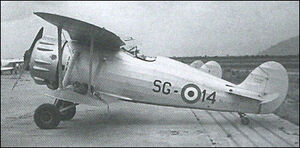
A IMAM Ro.41
The IMAM Ro.41 was an Italian light biplane fighter aircraft, serving in the Regia Aeronautica in the 1930s-1940s, mainly as a trainer.
It was a singular aircraft, being obsolescent as a fighter when it first appeared in 1934, but despite this it was used as such until 1940. The Luftwaffe showed an interest in it as a trainer, even though German first line fighters were completely different. The Ro.41 is almost unknown, compared to many other Italian aircraft, despite being one of the most numerous produced, in its 16-year career.
Development[]
The IMAM Ro.41 had its origins in the aircraft division of OFM (Officine Ferroviarie Meridionali). In 1929 Alessandro Tonini, the chief designer, had serious health problems and was replaced by Giovanni Galasso. This company, based in Naples, was taken over by Breda in 1935, and so Galasso's new aircraft designs received the IMAM designation of this company. One of the first was the Ro.41, flight tested by Niccolò Lana at Capodichino airfield on 16 June 1934.
The first prototype was fitted with a Piaggio P.VII engine, and showed itself to be very agile, with excellent climb performance, and no noticeable vices. The second prototype, MM.281, was tested 31 January 1935, and taken on strength with the Regia Aeronautica.
The third prototype had a Piaggio P.VII C.45 with two-stage compressor, giving 390 hp at 4,000 m. This was the definitive version of this aircraft, and fifty aircraft, numbers MM.2907-2956, were ordered. This first series was put in service in July 1935.
Design[]
A biplane, with the lower wing smaller than the upper, the Ro.41 was of mixed construction, the fuselage of chrome-molybdenum steel frame, covered in fabric. Duralumin covered the bottom and upper fuselage, and also the engine cowling. The wings were made of wood covered with fabric. There was a fixed undercarriage.
The engine gave a theoretical 425 hp at ground level, 450 hp at 1,500 m, and 390 hp at 4,500 m, although it was much less in practice. The reliability was very good. A 176-litre fuel tank was inside the fuselage, near the engine, together with a 20-litre oil tank. The propeller was two-bladed and made of wood, later replaced by a metal two-blade model.
Armament, when fitted, consisted of two 7.7 mm Breda-SAFAT machine guns mounted inside the fuselage, with 850 cartridges.